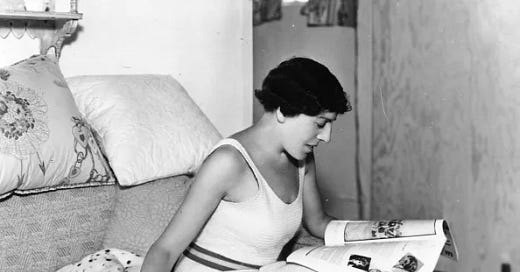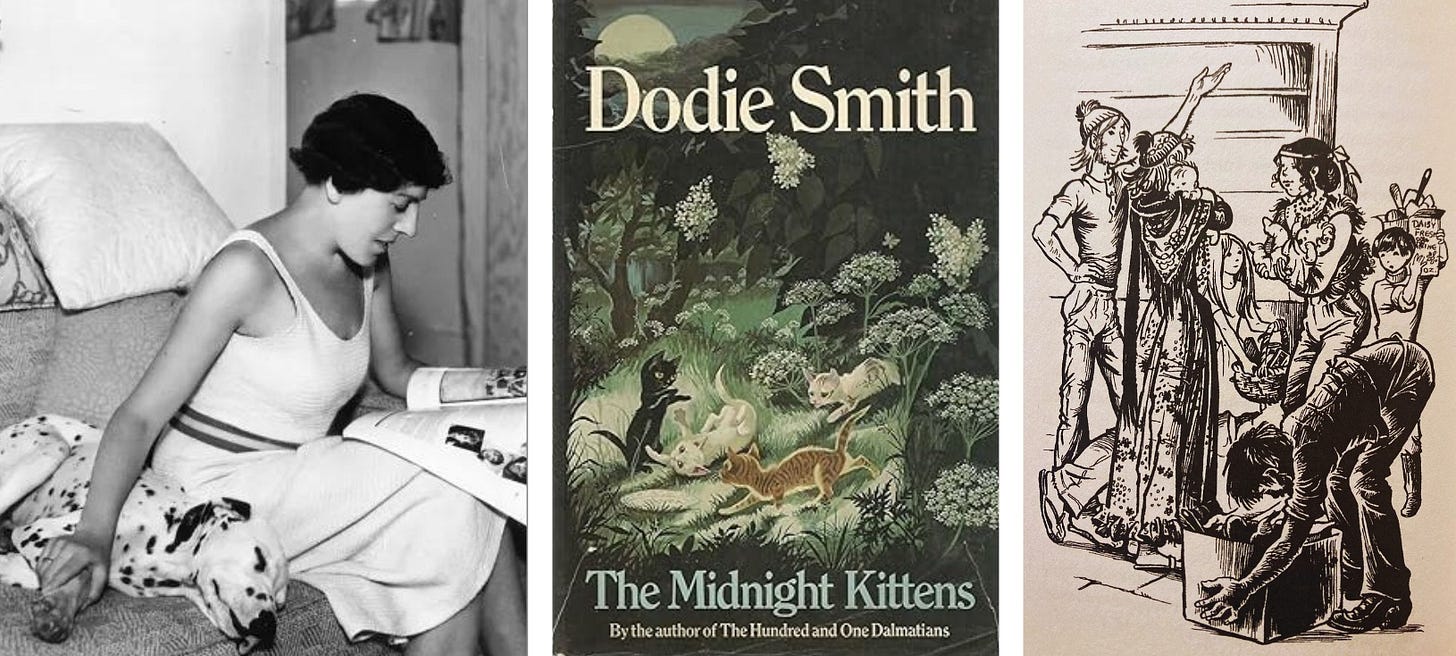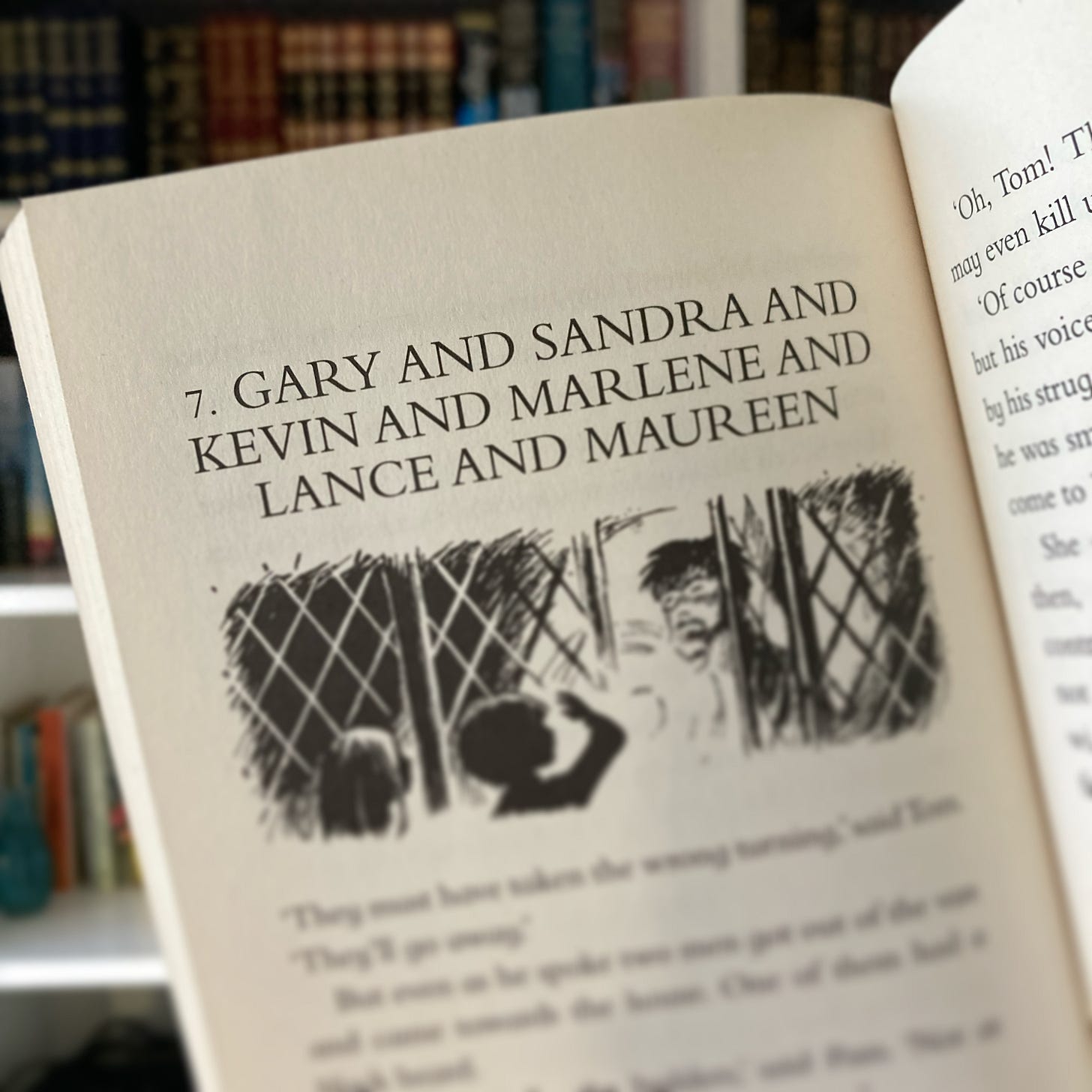Gram thought of all the years she herself had smoked. She had given it up when she inherited the twins. ‘One cannot,’ she had once said, ‘puff smoke in a baby’s face.’
Lesser-Known Works
The idea came into my head a few weeks ago that I had to read The Midnight Kittens by Dodie Smith, urgently. It was just another of those feverish days when I’m trying to figure out what I’m writing, while I’m writing it. Stumbling upon a description of a book, I’ll become convinced it holds the key to my writerly turmoil.
It almost never does — indeed, it didn’t in this case. However, nothing wasted.
The Midnight Kittens wasn’t easy to find, not being one of the two novels most people think of when they hear the name Dodie Smith. Many readers who call her a favourite don’t know of its existence, though they can quote the first line of I Capture the Castle (yes I can) and may own a Cruella wig (yes I do).
The Midnight Kittens was the last novel Dodie published, in 1978, at the age of eighty-two.
Tom and Pamela are twins whose parents were “killed instantaneously on a continental motorway” when they were babies, and have since lived with their widowed Gram in an English country village cottage with a thatched roof. The twins attend boarding school and visit Gram in the holidays. We meet them when they’ve been “put on the train”, being old enough to manage the journey alone at the ripe old age of ten. All of this early set-up is established with the pace and panache of a seasoned writer who thinks highly of her readers.
Tom, older by twenty minutes, is the reliable worrier (we firstborns can’t catch a break, even when we’re only older by twenty minutes), and Pamela is the dreamer. On the first night, the kids put out bread and milk for hedgehogs. At midnight, while they peer out of the cottage window — Gram hasn’t heard of bedtimes; she’s awesome — instead of hedgehogs, a litter of ravenous kittens appears.
Shortly, fanciful Pamela becomes convinced that the kittens are summoned by midnight, and are therefore magical. The plot thickens when the children explore an abandoned mansion and meet one of its oldest former residents, a 100-year-old woman called Miss Freke who tells them about a secret she hid there long ago.
If the plot sounds promising in summary, I have to be honest and say that I don’t think it works — it flags, it flummoxes, it fizzles a bit — but very fine writing, old charm, genuine respect and awe for children, and sophisticated themes, meant that I didn’t care a bit. I read with fascination, trying to work out what Dodie was trying to do and whether she knew it was her last novel.
What may stand out to a modern audience
1970s hedgehogs may have tolerated bread and milk but in 2023 they’re lactose intolerant and bread has no nutritional value, so we’re not doing that any more. But wild animals aside, Tom and Pam are living the dream food-wise: cake late at night, stews and puddings and sausages (it’s Britain, let us enjoy our stodge) and to top it all “a wine glass of Coca Cola”. I told you Gram was awesome.
On a more serious note, the thoughts and feelings of Gram amount to a quarter of the book, while Tom and Pam share the rest. The thoughts and feelings of a woman in her late fifties, in a children’s book! Can you imagine pitching this to a publisher today, without that middle-aged female being, say, a highly comical nanny pig?
Although Gram is conveniently got out of the way in order for Tom and Pamela to adventure without her guidance, the young reader is expected to empathise with what Gram is feeling. She maintains a thread about trying to keep up with the younger generation, and striving to respect and give freedom to her beloved grandkids. I liked that, and I can’t think why we’d assume that a young reader today wouldn’t — sometimes publishing is so nervous about what children like.
I talked about older women in children’s literature in my post about Mrs Pepperpot (which you can read here if you missed it).
The other stand-out is religion. This was an important topic for Dodie Smith, who became a Christian Scientist alongside her mother, Ella, when Ella was dying of breast cancer. In The Midnight Kittens, Pamela announces to Gram that she’s a staunch atheist. This news clearly affects Gram but she gently and politely questions Pamela. Themes of belief, goodness, and magic, are at the heart of this story.
The novel feels like a bittersweet goodbye to children, and children’s literature, particularly when Tom and Pamela become intrigued by Miss Freke in the nursing home, who recalls being their age. Dodie Smith lived twelve years past the publication of The Midnight Kittens, to ninety-four, and went very reluctantly to a nursing home, preferring to stay in her cottage and die with Charley, her last dalmatian.
Reading The Midnight Kittens made me wonder what it would be like to experience enormous success, as she did with I Capture the Castle (1948) and The Hundred and One Dalmatians (1956) and to go on writing throughout the 60s and 70s without hitting those high notes again. Perhaps she wasn’t striving any more. Perhaps she was simply writing.
Most of the time I don’t know if I’m striving or writing — or if I’ll ever stop. And on that note, if you’ve been struggling with the striving part, listen to Jen Storer’s recent podcast Episode 50: When It’s All Too Much (Girl & Duck podcast). Jen is a lot more spiritual than me (I’m about as spiritual as a yoghurt pot) and I love her wisdom. I’ll also write a post soon about how Jen’s creative writing teaching has been influential.
Briefly, back to those midnight kittens.
In Praise of Chapter Headings
There are only ten chapters in The Midnight Kittens but some of the headings capture why I’ve remembered a fondness for them and used them in recent novels. The most memorable here are Chapter 7: Gary and Sandra and Kevin and Marlene and Lance and Maureen (tell me you don’t want to read the book just to find out who they are), Chapter 9: Why Are You Inventing This Nonsense?, and the final chapter, Chapter 10: A Telephone Rings After Midnight.
I could tell you who Gary and Sandra and Kevin and Marlene and Lance and Maureen are, but perhaps it’s more fun if it remains a mystery.
Is there a lesser-known work by a famous author that you hold dear? As always, I’d love to hear about it.







